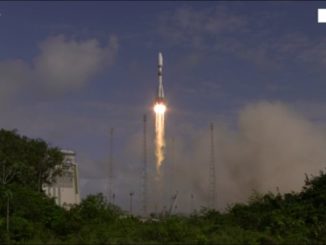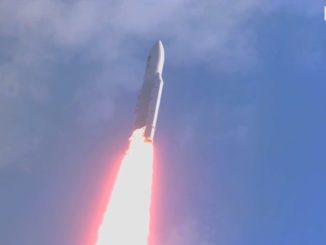
A new satellite launched Aug. 1 has joined the U.S. Air Force’s GPS navigation network to help guide everything from bombs to road trippers to their destinations, with final preparations on track to send up another GPS spacecraft at the end of October.
The Air Force declared the GPS 2F-7 spacecraft healthy and ready for operations Sept. 17, according to a statement released Monday by Boeing, the satellite’s manufacturer.
Valued at $245 million, the satellite launched Aug. 1 from Cape Canaveral on top of a United Launch Alliance Atlas 5 rocket, which deployed the craft in orbit about 12,700 miles above Earth.
Boeing said a government-industry operations team completed the initial activation and checkout of the satellite, known in the GPS constellation as Space Vehicle Number-68, in a record five days.
The Air Force’s 50th Space Wing at Schriever Air Force Base, Colo., took control of the satellite from Boeing on Aug. 8.
Ground controllers maneuvered the GPS 2F-7 spacecraft to its final orbital position in the GPS fleet’s “F Plane” in early September, taking the place of the aging GPS 2R-2 satellite launched by a Delta 2 rocket in July 1997. Prelaunch plans called for GPS 2R-2 to move to another position to replace the even-older GPS 2A-14 satellite launched by another Delta 2 booster in July 1992.
It was the seventh of 12 Boeing-built GPS 2F-series satellites to launch. The rest of the GPS 2F spacecraft, which have been manufactured and are in storage at Boeing’s satellite factory in El Segundo, Calif., are due to launch by mid-2016.
The next-generation GPS 3-series spacecraft — built by Lockheed Martin Corp. — are scheduled to begin launching in 2016.

“Boeing has delivered 45 of the 67 GPS satellites launched to date, accruing more than 525 years of on-orbit performance,” said Dan Hart, vice president of Boeing’s government space systems division. “It’s a track record of which we’re very proud, and we’re ready to get the remaining 2Fs into orbit and continue our contributions to GPS today and in the future.”
Officials have said users can expect more accurate positioning services as newer satellites launch to replace older members of the GPS fleet, which is dominated by spacecraft now operating beyond their design lifetimes.
As of September, the GPS network consisted of 31 satellites, including seven GPS 2F birds, 19 GPS 2R and GPS 2R-M spacecraft, and five GPS 2A satellites. The average age of the satellites is about 12 years, according to the Air Force.
Engineers last year finished uplinking commands to the GPS 2R and GPS 2R-M satellites to reduce their battery charging rates, a modification that officials expect to extend each spacecraft’s lifetime by one to two years.
The GPS 2F-8 satellite is at Cape Canaveral undergoing final preparations for liftoff Oct. 29 on an Atlas 5 launcher, and the GPS 2F-9 satellite is due for shipment from Boeing’s Southern California factory to Florida early next year for a launch on a Delta 4 rocket in March 2015.
The final three satellites in the GPS 2F series will launch in late 2015 and early 2016.



